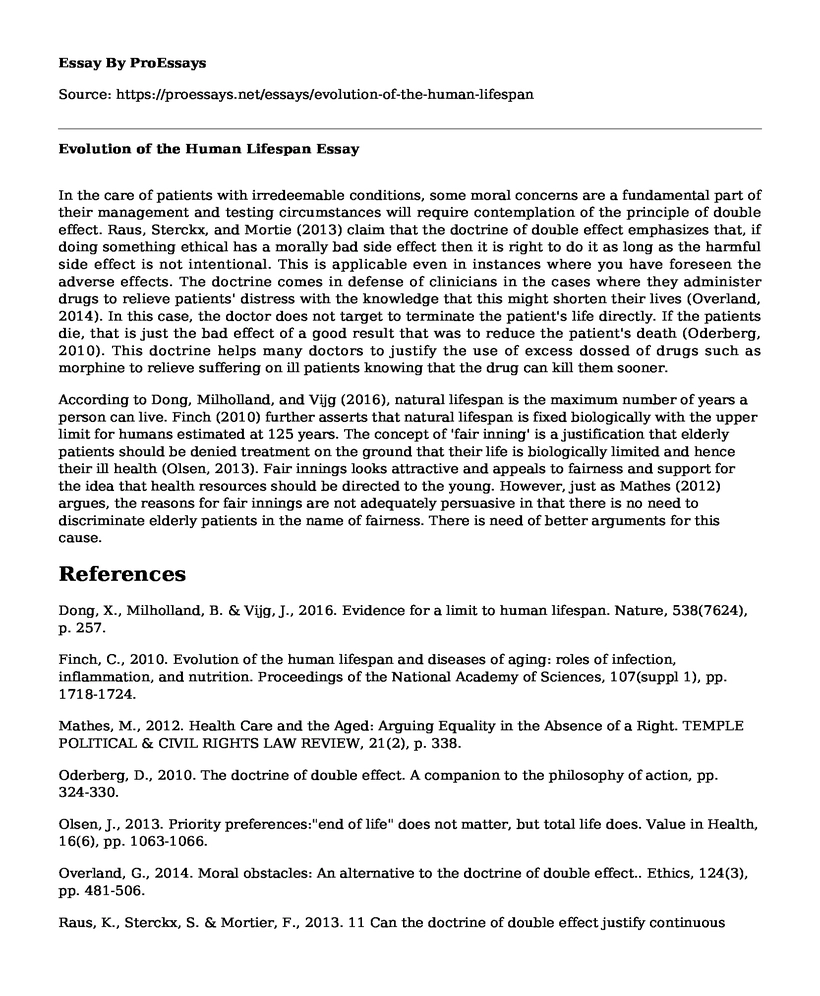According to Dong, Milholland, and Vijg (2016), natural lifespan is the maximum number of years a person can live. Finch (2010) further asserts that natural lifespan is fixed biologically with the upper limit for humans estimated at 125 years. The concept of 'fair inning' is a justification that elderly patients should be denied treatment on the ground that their life is biologically limited and hence their ill health (Olsen, 2013). Fair innings looks attractive and appeals to fairness and support for the idea that health resources should be directed to the young. However, just as Mathes (2012) argues, the reasons for fair innings are not adequately persuasive in that there is no need to discriminate elderly patients in the name of fairness. There is need of better arguments for this cause.
References
Dong, X., Milholland, B. & Vijg, J., 2016. Evidence for a limit to human lifespan. Nature, 538(7624), p. 257.
Finch, C., 2010. Evolution of the human lifespan and diseases of aging: roles of infection, inflammation, and nutrition. Proceedings of the National Academy of Sciences, 107(suppl 1), pp. 1718-1724.
Mathes, M., 2012. Health Care and the Aged: Arguing Equality in the Absence of a Right. TEMPLE POLITICAL & CIVIL RIGHTS LAW REVIEW, 21(2), p. 338.
Oderberg, D., 2010. The doctrine of double effect. A companion to the philosophy of action, pp. 324-330.
Olsen, J., 2013. Priority preferences:"end of life" does not matter, but total life does. Value in Health, 16(6), pp. 1063-1066.
Overland, G., 2014. Moral obstacles: An alternative to the doctrine of double effect.. Ethics, 124(3), pp. 481-506.
Raus, K., Sterckx, S. & Mortier, F., 2013. 11 Can the doctrine of double effect justify continuous deep sedation at the end of life?. Continuous Sedation at the End of Life: Ethical, Clinical and Legal Perspectives,, p. 177.
Cite this page
Evolution of the Human Lifespan. (2022, Mar 29). Retrieved from https://proessays.net/essays/evolution-of-the-human-lifespan
If you are the original author of this essay and no longer wish to have it published on the ProEssays website, please click below to request its removal:
- Breast Cancer Disease Analysis Paper
- Mental Illness and the Senior Citizen Essay Example
- Effective Communication in Nursing Essay Example
- Deaf Rights - Essay Sample
- Paper Example on Opioid Crisis: Examining Its Economic and Social Impacts
- Ensuring Financial Improvements in Reimbursement: Drintin Hospital - Essay Sample
- COVID-19: The Impact on Tourism & Travel Industry - Free Paper Example







